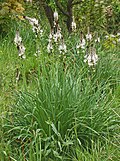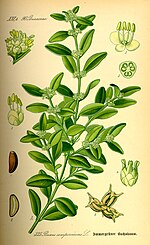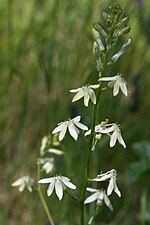 | The APG IV system of flowering plant classification is the fourth version of a modern, mostly molecular-based, system of plant taxonomy for flowering... 40 KB (2,558 words) - 13:57, 8 April 2024 |
was replaced by the improved APG II in 2003, APG III system in 2009 and APG IV system in 2016. The original APG system is unusual in being based, not... 20 KB (1,429 words) - 12:57, 26 July 2023 |
Group (APG). Published in 2009, it was superseded in 2016 by a further revision, the APG IV system. Along with the publication outlining the new system, there... 47 KB (3,194 words) - 04:17, 8 April 2024 |
 | Commelinids (section APG system) containing ferulic acid. The commelinids are the only clade that the APG IV system has informally named within the monocots. The remaining monocots are... 12 KB (837 words) - 03:56, 14 April 2024 |
The APG II system (Angiosperm Phylogeny Group II system) of plant classification is the second, now obsolete, version of a modern, mostly molecular-based... 7 KB (650 words) - 01:27, 20 October 2022 |
 | families into an order. The order remains unchanged in the APG IV system. Under the Cronquist system, the Zygophyllaceae were included within the Sapindales... 5 KB (334 words) - 05:42, 8 April 2024 |
 | flowering plants. The APG IV system of 2016 (unchanged from the APG III system of 2009, the APG II system of 2003 and the APG system of 1998) places the... 4 KB (360 words) - 03:06, 8 April 2024 |
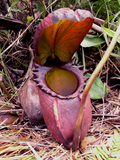 | Nepenthales (section APG IV system) currently favor the APG IV system of 2016 over the older Cronquist system for classifying flowering plants (Angiosperms). The 2009 APG III system assigned the... 3 KB (298 words) - 19:50, 28 April 2024 |
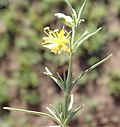 | order, and was reassigned to the new order Vahliales in 2016 by the APG IV system. Vahlia capensis (L. fil.) Thunb.; South Africa (Cape Prov.) Vahlia... 3 KB (228 words) - 00:55, 21 March 2024 |
 | Australia. The best known representative is Kingia australis. The 2016 APG IV system places the family in the order Arecales, after several studies revealed... 7 KB (591 words) - 05:35, 28 April 2024 |
 | The Angiosperm Phylogeny Group APG III system included the genera of Nyssaceae within Cornaceae. The APG IV system recognizes Nyssaceae as a distinct... 3 KB (330 words) - 12:42, 23 April 2024 |
 | recognized by the most recent classification of flowering plants, the APG IV system. It is defined to contain two families: Canellaceae and Winteraceae... 4 KB (365 words) - 03:33, 8 April 2024 |
 | recognized segregate family Myrothamnaceae. In the APG III system (2009) and APG IV system (2016) the narrower circumscription is preferred, and these... 5 KB (429 words) - 05:20, 8 April 2024 |
 | In the APG IV system (2016) for the classification of flowering plants, the name asterids denotes a clade (a monophyletic group). Asterids is the largest... 8 KB (649 words) - 03:37, 8 April 2024 |
 | Piperales (section APG system) Peperomias, pepper elder, lizard's tail, birthwort, and wild ginger. In the APG IV system, of 2016, this order is placed in the clade magnoliids and is circumscribed... 5 KB (327 words) - 04:49, 8 April 2024 |
 | Magnoliales (section APG system) hundred species including nutmeg) The APG system (1998), APG II system (2003), APG III system (2009), and APG IV system (2016) place this order in the clade... 7 KB (574 words) - 05:28, 8 April 2024 |
 | but is placed by other authorities in the family Nyssaceae. In the APG IV system, it is placed in Nyssaceae. Most Nyssa species are highly tolerant of... 10 KB (1,117 words) - 12:25, 23 April 2024 |
it always includes the family Asteraceae (Compositae). In the modern APG IV system of classification, asterid and euasterid are names for clades with a... 3 KB (322 words) - 10:23, 13 September 2023 |
 | species of the genus Gomortega and, according to the APG IV system of 2016 (unchanged from the APG systems of 2009, 2003 and 1998), of the monotypic family... 7 KB (616 words) - 05:44, 8 April 2024 |
 | taxonomists, with most systems putting the two genera, Borya and Alania, in the Anthericaceae or the Liliaceae. The 2016 APG IV system (unchanged from the... 4 KB (313 words) - 05:58, 8 April 2024 |
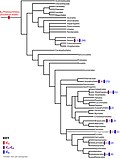 | Angiosperm Phylogeny Group (section APG IV (2016)) revisions have been published, in 2003 (APG II), in 2009 (APG III) and in 2016 (APG IV), each superseding the previous system. Thirteen researchers have been... 33 KB (3,527 words) - 05:32, 8 April 2024 |
 | Geraniales (section APG) Vivianiaceae. However, Considerable rearrangements took place in the 2016 APG IV system. Francoaceae was substituted for Melianthaceae, due to nomenclatural... 19 KB (1,825 words) - 05:23, 8 April 2024 |


